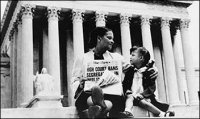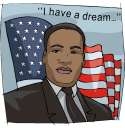
Worksheets and No Prep Teaching Resources
Reading Comprehension Worksheets
Black History and Blacks in U.S. History
The 1960's

Black History and Blacks in U.S. History
 Worksheets and No Prep Teaching Resources Reading Comprehension Worksheets Black History and Blacks in U.S. History The 1960's |
 Black History and Blacks in U.S. History |
| edHelper's suggested reading level: | grades 6 to 8 | |
| Flesch-Kincaid grade level: | 6.62 |
|
Introduction to Civil Rights - The 50's
By Jane Runyon |

|
 1 People in the United States followed the 1896 Supreme Court ruling of "separate but equal" facilities for over sixty years. Restaurants, restrooms, schools, even drinking fountains were designated for the use of "Whites Only" or "Blacks Only." This concept started to be tested again in the 1950's. The disagreements over this idea all started to boil over with the story of one little girl in Kansas.
1 People in the United States followed the 1896 Supreme Court ruling of "separate but equal" facilities for over sixty years. Restaurants, restrooms, schools, even drinking fountains were designated for the use of "Whites Only" or "Blacks Only." This concept started to be tested again in the 1950's. The disagreements over this idea all started to boil over with the story of one little girl in Kansas. |
Create Weekly Reading Books
Prepare for an entire week at once! |
| Leave your feedback on Introduction to Civil Rights - The 50's (use this link if you found an error in the story) |
 |
Black History and Blacks in U.S. History
|
 |
The 1960's
|
 |
Dr. Martin Luther King, Jr. Theme Unit and Printables
|
 |
Rosa Parks Activities, Worksheets, Printables, and Lesson Plans
|
 |
United States
|
|
|
 | Fifty States Theme Unit |
 |
Document Based Activities |